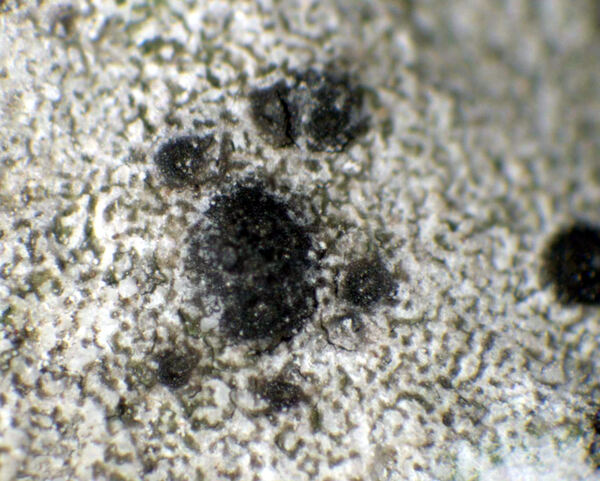Parabagliettoa cyanea (A. Massal.) Gueidan & Cl. Roux
Taxon, 58: 195, 2009. Basionym: Verrucaria cyanea A. Massal. - Mem. Lichenogr.: 144, 1853.
Synonyms: Involucrothele limitata (Nyl.) Servít; Thelidium limitatum (Nyl.) Servít; Verrucaria decussata Garov.; Verrucaria limitata (Nyl.) Kremp.
Distribution: N - VG, Frl (TSB 3746), Ven (Lazzarin 2000b, Watson 2014), TAA (Nascimbene & al. 2022), Lomb, Piem (Isocrono & al. 2004), Emil (Bouvet 2008, Fariselli & al. 2020), Lig. C - Tosc (Benesperi 2006), Laz (Nimis & Tretiach 2004), Mol (Garofalo & al. 1999, Genovesi & Ravera 2014), Sar. S - Camp (Garofalo & al. 1999, 2010, Aprile & al. 2003b), Pugl (Nimis & Tretiach 1999), Si (Nimis & al. 1994, Caniglia & Grillo 2005, 2006, Grillo & al. 2007b, Liistro & Cataldo 2011).
Description: Thallus crustose, endosubstratic to hemiendosubstratic in older parts, whitish to pale grey, sometimes with a brownish hue, with numerous, up to 100 μm wide flecks, smooth, delimited from adjacent conspecific thalli by sunken to slightly raised, single or double dark brown lines, the whole forming a clear mosaic. Pseudocortex formed by a thin prosoplectenchyma intermingled with microcrystals, sometimes with an upper layer of slightly pigmented cortical cells; medulla prosoplectenchymatous, white, K/I+ faintly violet, without macrosphaeroids. Perithecia black, immersed in the rock with only the black apex visible, or forming 0.2-0.35 μm wide, black projections, sometimes leaving poorly defined pits in the rock. Involucrellum confined to the apex of exciple or spreading sideways and downwards up to c. mid-level, 30-40 μm thick; exciple colourless to pale brown; hamathecium of periphyses and 15-20 μm long periphysoids, interascal filaments absent; hymenial gel hemiamyloid, I+ red (I+ blue at very low concentrations of I), K/I+ blue. Asci 8-spored, clavate, I-, fissitunicate, the wall thickened above, with an ocular chamber, dehiscent by extrusion of an endotunica to form a delicate rostrum, Verrucaria-type. Ascospores 1-celled, hyaline, ellipsoid (11-)13-20 x (5-)6-9 μm. Photobiont chlorococcoid. Spot tests: K-, C-, KC-, P-, UV-. Chemistry: without lichen substances.Note: on steeply inclined surfaces of compact limestone and dolomite in sheltered situations; optima in the submediterranean belt (in Northern Italy), and in the montane belt (in Southern Italy), much rarer, and mostly coastal, in shaded-humid situations of the eu-Mediterranean belt. The species differs from P. dufourii in the smaller, less prominent perithecia, and the thalli typically in a mosaic with conspecific thalli, separated by dark lines; the lines produced by one thallus typically do not merge completely with that of its neighbour, so the lines often appear double (Orange 2013).
Growth form: Crustose endolithic
Substrata: rocks
Photobiont: green algae other than Trentepohlia
Reproductive strategy: mainly sexual
Commonnes-rarity: (info)
Alpine belt: absent
Subalpine belt: absent
Oromediterranean belt: absent
Montane belt: rather common
Submediterranean belt: rare
Padanian area: absent
Humid submediterranean belt: rather rare
Humid mediterranean belt: very rare
Dry mediterranean belt: absent
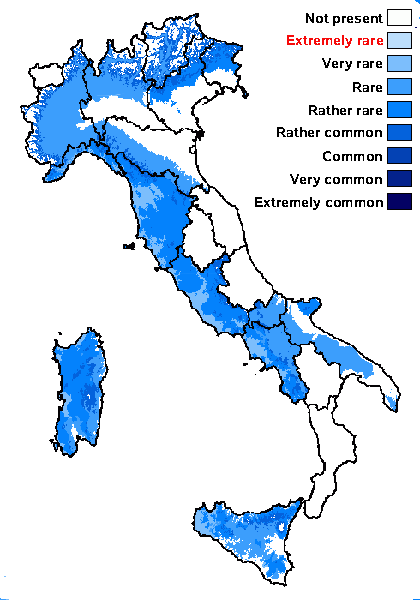
Predictive model
Herbarium samples


P.L. Nimis; Owner: Department of Life Sciences, University of Trieste
Herbarium: TSB (32438)
2002/02/23
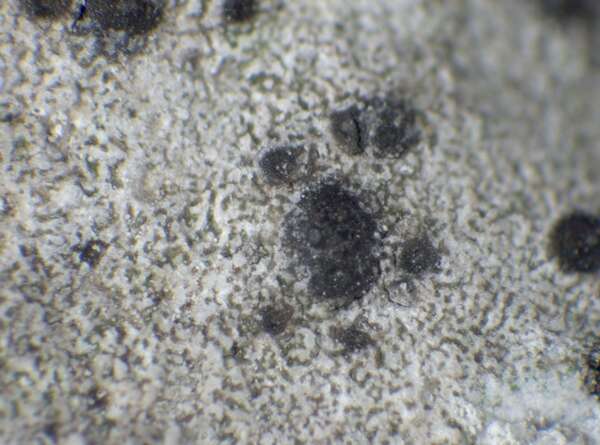

P.L. Nimis; Owner: Department of Life Sciences, University of Trieste
Herbarium: TSB (32438)
2002/02/23
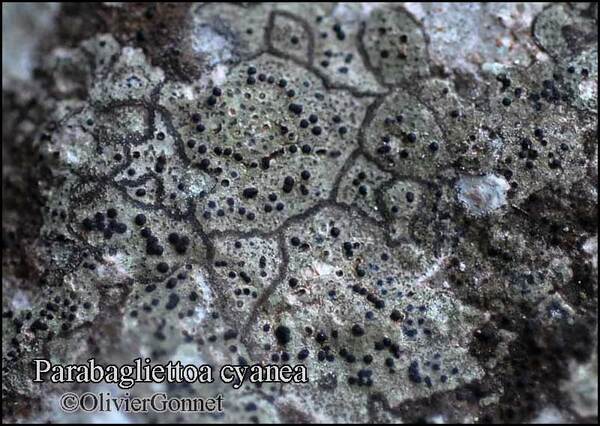
Courtesy Danièle et Olivier Gonnet - Source: https://www.afl-lichenologie.fr/Photos_AFL/Photos_AFL_P/Text_P/Parabagliettoa_cyanea.htm
France, Session AFL 2008 Ardèche
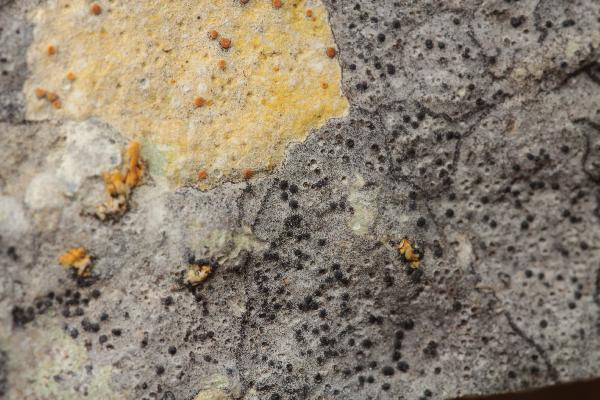
Collezione lichenologica Abramo Massalongo del Museo di Storia Naturale G. Ligabue di Venezia - Autori: Seggi, Linda; Trabucco, Raffaella Proprietà: Fondazione Musei Civici di Venezia - CC BY-NC
Italy, Veneto, in op. Garda (Rocca)
as Verrucaria cyanea
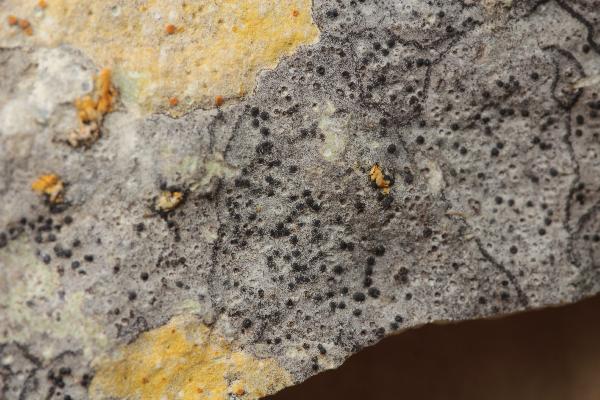
Collezione lichenologica Abramo Massalongo del Museo di Storia Naturale G. Ligabue di Venezia - Autori: Seggi, Linda; Trabucco, Raffaella Proprietà: Fondazione Musei Civici di Venezia - CC BY-NC
Italy, Veneto, in op. Garda (Rocca)
as Verrucaria cyanea
Growth form: Crustose endolithic
Substrata: rocks
Photobiont: green algae other than Trentepohlia
Reproductive strategy: mainly sexual
Commonnes-rarity: (info)
Alpine belt: absent
Subalpine belt: absent
Oromediterranean belt: absent
Montane belt: rather common
Submediterranean belt: rare
Padanian area: absent
Humid submediterranean belt: rather rare
Humid mediterranean belt: very rare
Dry mediterranean belt: absent

Predictive model
| Herbarium samples |


P.L. Nimis; Owner: Department of Life Sciences, University of Trieste
Herbarium: TSB (32438)
2002/02/23


P.L. Nimis; Owner: Department of Life Sciences, University of Trieste
Herbarium: TSB (32438)
2002/02/23

Courtesy Danièle et Olivier Gonnet - Source: https://www.afl-lichenologie.fr/Photos_AFL/Photos_AFL_P/Text_P/Parabagliettoa_cyanea.htm
France, Session AFL 2008 Ardèche

Collezione lichenologica Abramo Massalongo del Museo di Storia Naturale G. Ligabue di Venezia - Autori: Seggi, Linda; Trabucco, Raffaella Proprietà: Fondazione Musei Civici di Venezia - CC BY-NC
Italy, Veneto, in op. Garda (Rocca)
as Verrucaria cyanea

 INDEX FUNGORUM
INDEX FUNGORUM
 GBIF
GBIF
 DOLICHENS
DOLICHENS
